Yingying Zhang
Conformal Prediction Beyond the Horizon: Distribution-Free Inference for Policy Evaluation
Oct 29, 2025Abstract:Reliable uncertainty quantification is crucial for reinforcement learning (RL) in high-stakes settings. We propose a unified conformal prediction framework for infinite-horizon policy evaluation that constructs distribution-free prediction intervals {for returns} in both on-policy and off-policy settings. Our method integrates distributional RL with conformal calibration, addressing challenges such as unobserved returns, temporal dependencies, and distributional shifts. We propose a modular pseudo-return construction based on truncated rollouts and a time-aware calibration strategy using experience replay and weighted subsampling. These innovations mitigate model bias and restore approximate exchangeability, enabling uncertainty quantification even under policy shifts. Our theoretical analysis provides coverage guarantees that account for model misspecification and importance weight estimation. Empirical results, including experiments in synthetic and benchmark environments like Mountain Car, show that our method significantly improves coverage and reliability over standard distributional RL baselines.
Copy-Paste to Mitigate Large Language Model Hallucinations
Oct 01, 2025Abstract:While Retrieval-Augmented Generation (RAG) enables large language models (LLMs) to generate contextually grounded responses, contextual faithfulness remains challenging as LLMs may not consistently trust provided context, leading to hallucinations that undermine reliability. We observe an inverse correlation between response copying degree and context-unfaithful hallucinations on RAGTruth, suggesting that higher copying degrees reduce hallucinations by fostering genuine contextual belief. We propose CopyPasteLLM, obtained through two-stage high-copying response preference training. We design three prompting methods to enhance copying degree, demonstrating that high-copying responses achieve superior contextual faithfulness and hallucination control. These approaches enable a fully automated pipeline that transforms generated responses into high-copying preference data for training CopyPasteLLM. On FaithEval, ConFiQA and PubMedQA, CopyPasteLLM achieves best performance in both counterfactual and original contexts, remarkably with 12.2% to 24.5% accuracy improvements on FaithEval over the best baseline, while requiring only 365 training samples -- 1/50th of baseline data. To elucidate CopyPasteLLM's effectiveness, we propose the Context-Parameter Copying Capturing algorithm. Interestingly, this reveals that CopyPasteLLM recalibrates reliance on internal parametric knowledge rather than external knowledge during generation. All codes are available at https://github.com/longyongchao/CopyPasteLLM
MedKGent: A Large Language Model Agent Framework for Constructing Temporally Evolving Medical Knowledge Graph
Aug 17, 2025Abstract:The rapid expansion of medical literature presents growing challenges for structuring and integrating domain knowledge at scale. Knowledge Graphs (KGs) offer a promising solution by enabling efficient retrieval, automated reasoning, and knowledge discovery. However, current KG construction methods often rely on supervised pipelines with limited generalizability or naively aggregate outputs from Large Language Models (LLMs), treating biomedical corpora as static and ignoring the temporal dynamics and contextual uncertainty of evolving knowledge. To address these limitations, we introduce MedKGent, a LLM agent framework for constructing temporally evolving medical KGs. Leveraging over 10 million PubMed abstracts published between 1975 and 2023, we simulate the emergence of biomedical knowledge via a fine-grained daily time series. MedKGent incrementally builds the KG in a day-by-day manner using two specialized agents powered by the Qwen2.5-32B-Instruct model. The Extractor Agent identifies knowledge triples and assigns confidence scores via sampling-based estimation, which are used to filter low-confidence extractions and inform downstream processing. The Constructor Agent incrementally integrates the retained triples into a temporally evolving graph, guided by confidence scores and timestamps to reinforce recurring knowledge and resolve conflicts. The resulting KG contains 156,275 entities and 2,971,384 relational triples. Quality assessments by two SOTA LLMs and three domain experts demonstrate an accuracy approaching 90\%, with strong inter-rater agreement. To evaluate downstream utility, we conduct RAG across seven medical question answering benchmarks using five leading LLMs, consistently observing significant improvements over non-augmented baselines. Case studies further demonstrate the KG's value in literature-based drug repurposing via confidence-aware causal inference.
CaPulse: Detecting Anomalies by Tuning in to the Causal Rhythms of Time Series
Aug 06, 2025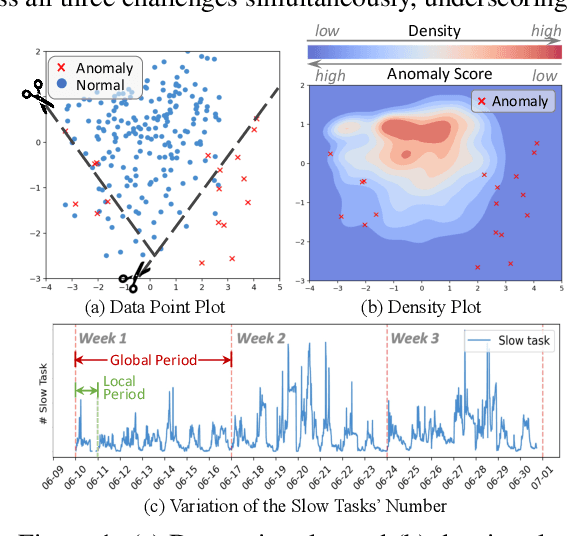
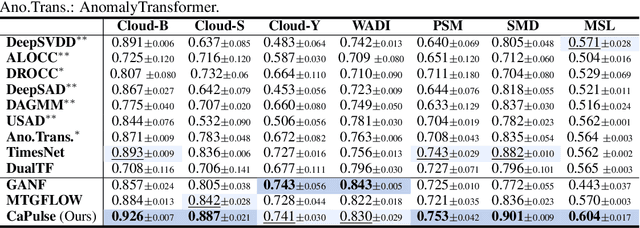
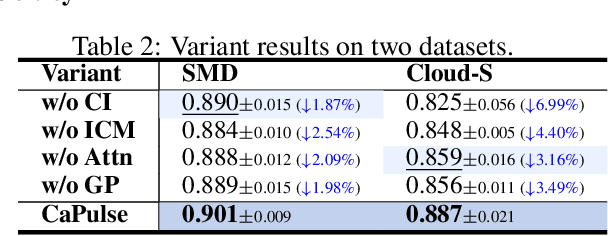
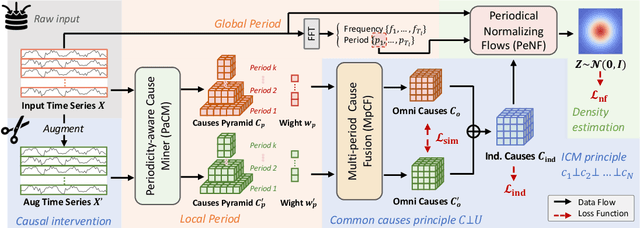
Abstract:Time series anomaly detection has garnered considerable attention across diverse domains. While existing methods often fail to capture the underlying mechanisms behind anomaly generation in time series data. In addition, time series anomaly detection often faces several data-related inherent challenges, i.e., label scarcity, data imbalance, and complex multi-periodicity. In this paper, we leverage causal tools and introduce a new causality-based framework, CaPulse, which tunes in to the underlying causal pulse of time series data to effectively detect anomalies. Concretely, we begin by building a structural causal model to decipher the generation processes behind anomalies. To tackle the challenges posed by the data, we propose Periodical Normalizing Flows with a novel mask mechanism and carefully designed periodical learners, creating a periodicity-aware, density-based anomaly detection approach. Extensive experiments on seven real-world datasets demonstrate that CaPulse consistently outperforms existing methods, achieving AUROC improvements of 3% to 17%, with enhanced interpretability.
CasP: Improving Semi-Dense Feature Matching Pipeline Leveraging Cascaded Correspondence Priors for Guidance
Jul 23, 2025Abstract:Semi-dense feature matching methods have shown strong performance in challenging scenarios. However, the existing pipeline relies on a global search across the entire feature map to establish coarse matches, limiting further improvements in accuracy and efficiency. Motivated by this limitation, we propose a novel pipeline, CasP, which leverages cascaded correspondence priors for guidance. Specifically, the matching stage is decomposed into two progressive phases, bridged by a region-based selective cross-attention mechanism designed to enhance feature discriminability. In the second phase, one-to-one matches are determined by restricting the search range to the one-to-many prior areas identified in the first phase. Additionally, this pipeline benefits from incorporating high-level features, which helps reduce the computational costs of low-level feature extraction. The acceleration gains of CasP increase with higher resolution, and our lite model achieves a speedup of $\sim2.2\times$ at a resolution of 1152 compared to the most efficient method, ELoFTR. Furthermore, extensive experiments demonstrate its superiority in geometric estimation, particularly with impressive cross-domain generalization. These advantages highlight its potential for latency-sensitive and high-robustness applications, such as SLAM and UAV systems. Code is available at https://github.com/pq-chen/CasP.
Model Merging for Knowledge Editing
Jun 14, 2025Abstract:Large Language Models (LLMs) require continuous updates to maintain accurate and current knowledge as the world evolves. While existing knowledge editing approaches offer various solutions for knowledge updating, they often struggle with sequential editing scenarios and harm the general capabilities of the model, thereby significantly hampering their practical applicability. This paper proposes a two-stage framework combining robust supervised fine-tuning (R-SFT) with model merging for knowledge editing. Our method first fine-tunes the LLM to internalize new knowledge fully, then merges the fine-tuned model with the original foundation model to preserve newly acquired knowledge and general capabilities. Experimental results demonstrate that our approach significantly outperforms existing methods in sequential editing while better preserving the original performance of the model, all without requiring any architectural changes. Code is available at: https://github.com/Applied-Machine-Learning-Lab/MM4KE.
* 11 pages, 3 figures
DLP: Dynamic Layerwise Pruning in Large Language Models
May 27, 2025Abstract:Pruning has recently been widely adopted to reduce the parameter scale and improve the inference efficiency of Large Language Models (LLMs). Mainstream pruning techniques often rely on uniform layerwise pruning strategies, which can lead to severe performance degradation at high sparsity levels. Recognizing the varying contributions of different layers in LLMs, recent studies have shifted their focus toward non-uniform layerwise pruning. However, these approaches often rely on pre-defined values, which can result in suboptimal performance. To overcome these limitations, we propose a novel method called Dynamic Layerwise Pruning (DLP). This approach adaptively determines the relative importance of each layer by integrating model weights with input activation information, assigning pruning rates accordingly. Experimental results show that DLP effectively preserves model performance at high sparsity levels across multiple LLMs. Specifically, at 70% sparsity, DLP reduces the perplexity of LLaMA2-7B by 7.79 and improves the average accuracy by 2.7% compared to state-of-the-art methods. Moreover, DLP is compatible with various existing LLM compression techniques and can be seamlessly integrated into Parameter-Efficient Fine-Tuning (PEFT). We release the code at https://github.com/ironartisan/DLP to facilitate future research.
Think or Not? Exploring Thinking Efficiency in Large Reasoning Models via an Information-Theoretic Lens
May 23, 2025Abstract:The recent rise of Large Reasoning Models (LRMs) has significantly improved multi-step reasoning performance, but often at the cost of generating excessively long reasoning chains. This paper revisits the efficiency of such reasoning processes through an information-theoretic lens, revealing a fundamental trade-off between reasoning length and semantic efficiency. We propose two metrics, InfoBias and InfoGain, to quantify divergence from ideal reasoning paths and stepwise information contribution, respectively. Empirical analyses show that longer reasoning chains tend to exhibit higher information bias and diminishing information gain, especially for incorrect answers. Motivated by these findings, we introduce an entropy-based Adaptive Think strategy that dynamically halts reasoning once confidence is sufficiently high, improving efficiency while maintaining competitive accuracy. Compared to the Vanilla Think approach (default mode), our strategy yields a 1.10% improvement in average accuracy and a 50.80% reduction in token usage on QwQ-32B across six benchmark tasks spanning diverse reasoning types and difficulty levels, demonstrating superior efficiency and reasoning performance. These results underscore the promise of entropy-based methods for enhancing both accuracy and cost-effiiciency in large language model deployment.
LifelongAgentBench: Evaluating LLM Agents as Lifelong Learners
May 17, 2025Abstract:Lifelong learning is essential for intelligent agents operating in dynamic environments. Current large language model (LLM)-based agents, however, remain stateless and unable to accumulate or transfer knowledge over time. Existing benchmarks treat agents as static systems and fail to evaluate lifelong learning capabilities. We present LifelongAgentBench, the first unified benchmark designed to systematically assess the lifelong learning ability of LLM agents. It provides skill-grounded, interdependent tasks across three interactive environments, Database, Operating System, and Knowledge Graph, with automatic label verification, reproducibility, and modular extensibility. Extensive experiments reveal that conventional experience replay has limited effectiveness for LLM agents due to irrelevant information and context length constraints. We further introduce a group self-consistency mechanism that significantly improves lifelong learning performance. We hope LifelongAgentBench will advance the development of adaptive, memory-capable LLM agents.
Agent RL Scaling Law: Agent RL with Spontaneous Code Execution for Mathematical Problem Solving
May 14, 2025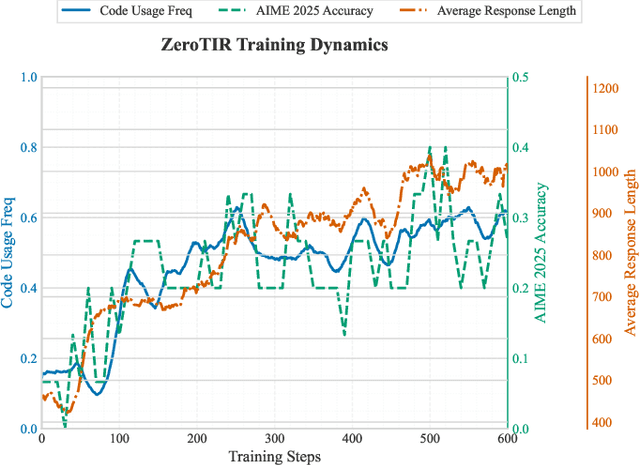

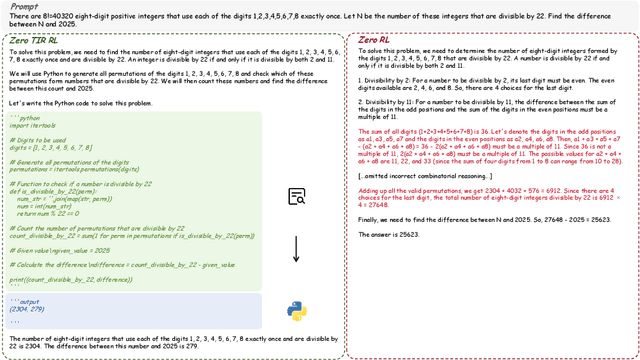
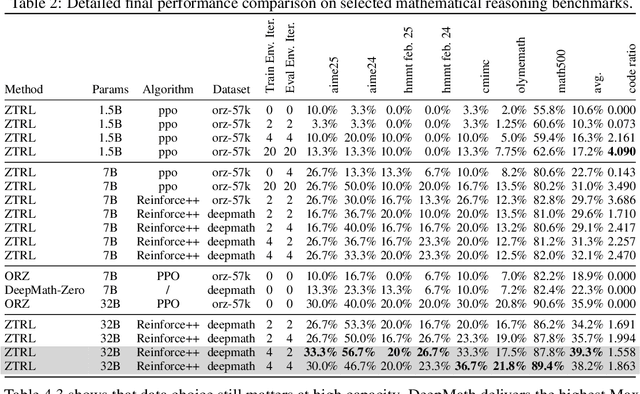
Abstract:Large Language Models (LLMs) often struggle with mathematical reasoning tasks requiring precise, verifiable computation. While Reinforcement Learning (RL) from outcome-based rewards enhances text-based reasoning, understanding how agents autonomously learn to leverage external tools like code execution remains crucial. We investigate RL from outcome-based rewards for Tool-Integrated Reasoning, ZeroTIR, training base LLMs to spontaneously generate and execute Python code for mathematical problems without supervised tool-use examples. Our central contribution is we demonstrate that as RL training progresses, key metrics scale predictably. Specifically, we observe strong positive correlations where increased training steps lead to increases in the spontaneous code execution frequency, the average response length, and, critically, the final task accuracy. This suggests a quantifiable relationship between computational effort invested in training and the emergence of effective, tool-augmented reasoning strategies. We implement a robust framework featuring a decoupled code execution environment and validate our findings across standard RL algorithms and frameworks. Experiments show ZeroTIR significantly surpasses non-tool ZeroRL baselines on challenging math benchmarks. Our findings provide a foundational understanding of how autonomous tool use is acquired and scales within Agent RL, offering a reproducible benchmark for future studies. Code is released at \href{https://github.com/yyht/openrlhf_async_pipline}{https://github.com/yyht/openrlhf\_async\_pipline}.
 Add to Chrome
Add to Chrome Add to Firefox
Add to Firefox Add to Edge
Add to Edge